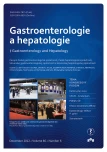Rare mycotic complications following liver transplant
Authors:
L. Husová 1; I. Kocmanová 2; V. Žampachová 3; R. Pařízková 4; V. Mejzlík 1; M. Kuman 1; S. Štěpánková 1; P. Němec 1
Authors‘ workplace:
Centrum kardiovaskulární a transplantační chirurgie Brno
1; Oddělení klinické mikrobiologie, FN Brno
2; I. patologicko-anatomický ústav LF MU a FN u sv. Anny v Brně
3; Klinika infekčních chorob, LF MU a FN Brno
4
Published in:
Gastroent Hepatol 2012; 66(6): 482-488
Category:
Hepatology: Case Report
Overview
A total of 420 liver transplants were carried out at the transplant centre in Brno between 2 February 1983 and 31 December 2011. We observed an unusual and serious mycotic infection, which was not caused by candida or aspergillus, in a total of five patients. We found one case each of Cladophialophora bantiana and Fonsecaea compacta infection. In three cases the infection was caused by Cryptococcus neoformans. Three patients (3/5 = 60%) died of the aforementioned infection. The authors describe the case of a 44-year old man with abscesses of the lungs and brain, caused by black fungus (Cladophialophora bantiana). Despite the application of the full spectrum of antimycotic therapy and surgical procedures, the infection continued to progress, resulting in the death of the patient. The second patient, a 54-year old woman, had developed recidivising skin infiltrations, which were examined from a histological, microscopic and cultivatory point of view, with the presence of Fonsecaea compacta demonstrated. While repeated surgical interventions were required to remove deposits following recidivism, only the introduction of antimycotic therapy led to its complete disappearance. The patient has shown no signs of infection for seven years. The authors further describe the case of a 56-year old man with a haematogenic spread of mycotic infection of the skin caused by Cryptococcus neoformans. In this case, the surgical removal of skin deposits and long-term antimycotic therapy led to the regression of the infection and stabilisation of the patient. In the fourth case study, the authors describe the case of a 56-year old man after orthotopic liver transplantation and with early onset encephalitis, bilateral bronchial pneumonia, which led to the death of the patient on the 40th day following transplant. The etiology of the infection (Cryptococcus neoformans) was demonstrated following post mortem microscopic examination. The fifth patient was a 31-year old man with primary biliary cirrhosis, on whom a liver transplant was performed, accompanied by the reconstruction of the biliary tracts using a Roux loop. The operation and early post-operative period passed without complications. From the 12th day following surgery the patient suffered loss of consciousness and Cryptococcus neoformans was found in the lumbar puncture. Despite the introduction of therapy, the patient died of brain oedema within three months.
Key words:
mycotic infections – liver transplantation
The authors declare they have no potential conflicts of interest concerning drugs, products, or services used in the study.
The Editorial Board declares that the manuscript met the ICMJE „uniform requirements“ for biomedical papers.
Submitted:
18. 7. 2012
Accepted:
24. 9. 2012
Sources
1. Drastich P. Infekční komplikace po transplantaci jater. In: Trunečka P, Adamec L. Transplantace jater. Praha: Karolinum 2009: 196–206.
2. Alexander BD, Hanson K. Infections in the transplant recipient. In: Killenberg PG, Clavien PA. Liver transplant patient. Blackwell publishing 2006: 439–459, 3rd edition.
3. Li DM, De Hoog GS. Cerebral phaeohyphomycosis-a cure at what lengths? Lancet Infect Dis 2009; 9(6): 376–383.
4. Horré R, De Hoog GS. Primary cerebral infections by melanized fungi: a review. Stud Mycol 1999; 43: 176–193.
5. Al-Abdely HM, Alkhunaizi AM, Al-Tawfiq JA et al. Successful therapy of cerebral phaeohyphomycosis due to Ramichloridum mackenziei with the new triazole posaconazole. Med Mycol 2005; 43(1): 91–95.
6. Delfino D, De Hoog GS, Polonelli L et al. Survival of a neglected case of brain abscess caused by Cladiophialophora bantiana. Med Mycol 2006; 44(7): 651–654.
7. Harrison DK, Moser S, Palmer CA. Central nervous system infections in transplant recipients by Cladiophialophora bantiana. South Med J 2008; 101(3): 292–296.
8. Takei H, Goodman JC, Powell SZ. Cerebral phaeohyphomycosis caused by Cladiophialophora bantiana and Fonsecaea monophora. Report of three cases. Clin Neurophatol 2007; 26(1): 21–27.
9. Osiyemi OO, Dowdy LM, Mallon SM et al. Cerebral phaeophyphomycosis due to a novel species: report of case and review of the literature. Transplantation 2001; 71(9): 1343–1346.
10. Silveira FP, Husain S. Fungal infections in solid organ transplantation. Med Mycol 2007; 45(4): 305–320.
11. Paya CV. Fungal infections in solid – organ transplantation. Clin Infect Dis 1993; 16(5): 677.
12. Reed A, Herndon JB, Ersoz N et al. Effect of prophylaxis on fungal infection and cost for high – risk liver transplant recipients. Liver Transplantation 2007; 13(12): 1743–1750.
13. Levin PL, Baty DE, Fekete T et al. Cladophialophora bantiana brain absces in solid-organ transplant recipient: case report and review of the literature. J Clin Micro 2004; 42(9): 4374–4378.
14. Pradeep B, Raghavendra T, Chandramohan K et al. Multiple asymptomatic verrucous plaques over the legs. Indian J Dermatol Venerol Leprol 2010; 76(1): 86.
15. Wu B, Liu H, Huang J et al. Pulmonary cryptococcosis in non-AIDS patients. Clin Invest Med 2009; 32(1): E70–77.
16. Fishman J. Infection in Solid Organ Transplant Recipients. Medical Progress. N Engl J Med 2007; 357(25): 2601–2614.
17. Akamatsu N, Sugawara Y, Kanwko S et al. Preemptive treatment of fungal infection based on plasma (1–3) ß-D-glucan levels after liver transplantation. Infection 2007; 35(5): 346–351.
18. Chen SF, Lu CH, Lui CC et al. Acute//subacute cerebral infarction (ASCI) in HIV--negative adults with cryptococcal meningoencephalitis (CM): a MRI-based follow-up study and a clinical comparison to HIV-negative CM adults without ASCI. BMC Neurol 2011; 11: 12.
Labels
Paediatric gastroenterology Gastroenterology and hepatology SurgeryArticle was published in
Gastroenterology and Hepatology

2012 Issue 6
Most read in this issue
- Somatostatin and its use
- Omeprazole
- Clostridium difficile – a rising threat?
- Comparison of the tolerance and quality of bowel preparation before colonoscopy using picosulphate / magnesium citrate or polyethylene glycol in different dosing regimens
